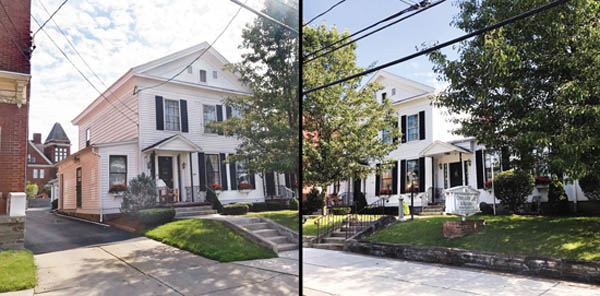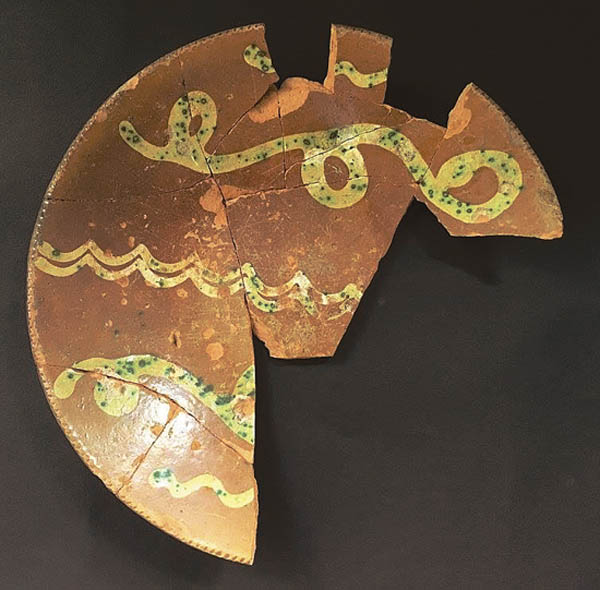The Wares Made By John Betts Gregory In Clinton, New York
An Examination Of Empire State Regional Redware
By Justin W. Thomas - April 16, 2021
While traveling through upstate New York in the summer of 2019 with my nephew Jason and niece Alexis, we stopped at the Clinton Historical Society to learn more about the museums collection of advertising slipware made by John Betts Gregory (1782-1842) in downtown Clinton. We were also given a tour of the site of the pottery and learned that very little archaeology survives from this business today because of late 19th and 20th century development. As a result, it is almost impossible to differentiate the lesser decorated slipware made by Gregory in Clinton from what he also made in Norwalk, Conn., and at the Huntington Pottery on Long Island. But we also learned that little is known about Gregorys simpler production without slip, and that some of his slipware in Clinton can even be mistaken for wares made in Pennsylvania. However, to understand Gregorys work in Clinton, one must likely examine his entire career first. In 1896, Reverend Charles Melbourne Selleck (1831-1909) wrote Norwalk in an attempt to bring the towns history fully to light, and to preserve and to perpetuate its mentions and memoirs. Many of these were gathered by the author while engaged in the necessarily hasty preparation of his 1886 St. Pauls Church centenary address in Norwalk, Conn., but most of them have since been collected, and their public presentation upon the eve of the towns quarter-millennial birth anniversary. As part of Reverend Sellecks history of Norwalk was the life of John Betts Gregory, a potter who began and ended his career in Norwalk. Although I believe Reverend Sellecks recount was the first time Gregorys entire career had been published, he was later cited in some 20th century historical and pottery related publications. According to Reverend Selleck, John Betts Gregory was born in Norwalk in 1782 to Abraham and Elizabeth Gregory, who lived where the late Henry Marvin resided, on East Avenue, and south of the ancient Beacham Lane. He learned his trade (potter) of Absalom Day (1770-1843) of Old Well (neighborhood in Norwalk). After his marriage to Olive (1786-1883), he had a good business offer from Huntington, Long Island, which he accepted. He afterward established a pottery in Clinton, Oneida County, N.Y., which required a building 140-by-40 for his operations. He returned in 1831 to Norwalk and bought from Samuel Hanford, Half-Mile Isle, paying $325. He there built a kiln for the burning of earthenware and stoneware. The kiln was erected in 1832 by masons Lewis and George Raymond of Old Well. The business was here kept up until 1840. Mr. Gregory died July 22, 1842. The Pottery in Clinton, New York Situated almost 50 miles east of Syracuse, between Rochester and Albany, the Village of Clinton was settled in 1787 by Revolutionary War veterans and families from Plymouth, Litchfield County, Conn., having been named after New Yorks first governor, George Clinton (1739-1812). This settlement eventually expanded into a town, joining Kirkland in the 19th century, but the original village was listed on the National Register of Historic Places in 1982. The reason why Gregory moved to landlocked upstate New York may have been a simple desire to operate his own pottery, but he may have also heard news of Clintons connection to Connecticut and other areas in this part of New York. There may have also been a financial incentive to move. Gregory arrived in Clinton sometime around 1808-10 with his wife and two daughters, purchasing a pottery from Erastus Barnes, Clintons first known potter. But Gregorys desire to move north may have also been a religious quest, seeing that at the time, parts of New York were engulfed with new religious movements in the early 19th century, finding much of this activity in central and western upstate New York. Aside from his family, Gregory brought along his knowledge of slip-decoration and slip-script, which he had learned from Absalom Day in Connecticut, a New Jersey trained potter who arrived in Norwalk about 1793. He likely practiced this type of production while employed in Huntington, as well, sometime around the late-18th and early-19th century. Gregory may have been the first red earthenware potter producing slip-decorated pottery in upstate New York, a technique that was already practiced in downstate New York and later embraced by a number of potters employed in Western New York and even a business in northern New York. But he clearly manufactured a lot of wares while employed in Clinton for about 20 years, ca. 1810-29. The most notable of those objects today are the wares that were decorated with slip, but he must have produced simpler decorated pottery in the same manner. Much of this production was also likely intended for local consumption. Unfortunately, not much is left of the Clinton Pottery today, since the Owens-Pavlot Funeral Home was built on top of the pottery in the 19th century, which also occupies Betts home, having been established in 1867. While visiting the area, we walked around this building in search of any artifacts, and did find some broken red earthenware, but nothing significant. Interestingly, the personalities of most early American potters are not known; however, author, Amos Delos Gridley published History of the Town of Kirkland, New York in 1874, describing the businesses of Erastus Barnes and Gregory, as well as a first-hand account he had been told by someone who knew Gregory: Erastus Barnes established the first pottery in Clinton, his works being nearly in the rear of the late Reverend Charles Jeromes residence on College Street (Hamilton College established in 1793). He found clay of an excellent quality on the Gleason farm, near Manchester, and his business was, for those times, large and lucrative. Mr. John B. Gregory succeeded him, and carried on the same industry for several years. He was quite a recluse, being seldom seen outside of his own premises. Yet he had a genial soul, and loved to scatter jokes and bits of humor among old and young who came to inspect his works or to buy his wares. He was a devout Methodist. Placing a lump of clay on his lathe, he would set his wheel a-spinning, and, while moulding pan or jug or other vessel, would burst into some old refrain, as Behold the potter and the clay! He forms his vessels as he please. Among the best known examples of slipware produced by Gregory in Clinton is a large slip-script plate, Why / Will You / Die, which has been published, and was owned for many years by retired New York State archaeologist and museum specialist George Hamell, later owned by New York City ceramic specialist Garrison Stradling, and owned today by Robesonia, Pa., antiques dealer Greg Kramer. Other notable objects of interest include a slip-decorated vase with two eagles, a slip-decorated pitcher with eagles inscribed Clinton Ware, as well as another plate inscribed, Made / By J B G / Oct 18 1823 / Clinton, which is considered one of the earliest examples of dated and signed red earthenware from New York. In Retrospect Upon arriving back in Norwalk, Conn., in 1831, Gregory continued to produce red earthenware with apparently a large focus still given to slipware. Examples of his production from this period seem to have been exported to the New York City market, based on some examples recovered in various archaeological contexts, including artifacts found on Staten Island in the collection of the Staten Island Historical Society. The wares he made at the Huntington Pottery were also likely exported to New York City. The wares he made in Clinton may be the most compelling of his production, as well as some of the most accomplished pottery manufactured anywhere in upstate New York. He is undoubtedly one of New Yorks most significant red earthenware potters from the 18th or 19th century. Sources Miller, Richard. Norwalk (Connecticut) Slip-script Pottery, the Potters, and Related Ware. Ceramics in America, 2016. Selleck, Charles Melbourne. Norwalk. Norwalk, CT.: Published by the author, 1896. Thomas, Justin W. The Red Earthenware Available in the 18th and 19th Centuries in New York City. Maine Antique Digest, October 2018. Thomas, Justin W. Early Red Earthenware & Stoneware Found on Staten Island. Antiques & the Arts Weekly, Jan. 31, 2020.










SHARE
PRINT